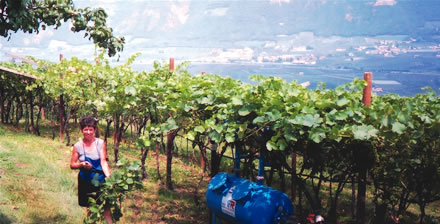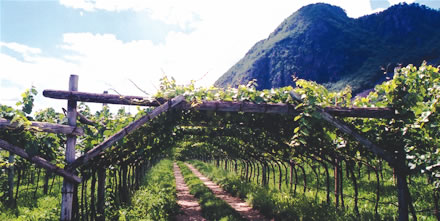
|
|
PRINT » |
|
|
E-MAIL THIS PAGE » |
|
|
CLOSE THIS WINDOW » |
Feature Article from the June 2006 Magazine Issue
Alto Adige Changes Its Image

In an effort to reduce yields and increase quality, growers practice canopy management, as seen here in vineyards below Castel Appiano.
Photos: Rudi Graeter
These are high altitude vineyards. Still, days can be exceedingly hot, but most nights, temperatures drop precipitously. These temperature swings give Alto Adige wines their zesty mouthfeel and lively perfume.
Alto Adige's total wine production is dwarfed by most other Italian appellations. Yet relative to its volume, its wineries have earned more Tre Bicchieri awards from Italian wine magazine Gambero Rosso than any other wine region in Italy. Why is this amazing? Not long ago, Alto Adige was the bargain basement for cheap red wines for its northern neighbors Germany, Switzerland and Austria.
Granted, most Italian wine regions have recently awakened from centuries of complacency. But the ferment that transformed much of Italy's wine industry had perhaps an even greater impact on Alto Adige. Be it the "Teutonic rigor" of its German-speaking inhabitants or the relative tidiness of a small wine region, there are few growers and nary a winery which haven't been swept up in the fervor to strive for ever better quality.
A case in point is the Weger family of Cornaiano (Girlan), whose involvement in the wine industry dates back to the year 1820. Alto Adige (also known as Südtirol) was then part of Austria and began to be a major supplier of red wines to other lands of the Austro-Hungarian Empire. Today, the young, affable Dr. Johannes Weger is in the process of radically transforming the business. Trading in bulk wines is no longer viable and much of the ancient cellars stand empty. Dr. Weger has repositioned this traditional merchant house as a quality estate.
Austria To Italy
For almost seven centuries, Südtirol was part of Austria. Only after the defeat of the Austro-Hungarian Empire in World War I was the province forced to become part of Italy, an event that was hugely unpopular among its people.
The annexation by Italy cut Südtirol off from its traditional export markets in Austria, Germany and Switzerland, and viticulture languished. Competing in the Italian market with its abundance of cheap reds was out of the question. Growers turned many vineyards into orchards whose produce promised higher returns.
Local demand helped the industry survive. Exports didn't pick up until the post World War II economic revival of Germany and Austria. These were not markets that demanded sophistication and finesse. Instead, they wanted cheap quaffing wines. The red wines of Alto Adige fit the bill perfectly.
At the time, 75% percent of Alto Adige vineyards were planted to red varieties. The indigenous variety Schiava (Vernatsch) had the lion's share with 60%. Clonal selection, chemical fertilizers and irrigation had made the vineyards enormously productive, with corresponding mediocrity in the resulting wines.
But the bottom fell out of this market by the late 1970s. Greater prosperity and increasing sophistication made consumers turn away from mass-produced wines, and Alto Adige had to find a brand-new bag. The future looked bleak indeed for the growers, most of whom are to this day small-vineyard holders who supplement their income with orchard produce and agri-tourism.

Although picturesque, the traditional practice of growing vines on pergolas is fading out, as growers turn to trellised vines.
At this crucial juncture, Alto Adige growers had the good fortune to be led by two visionary personalities. Alois Lageder chaired the organization of private estates, while Luis Raifer occupied the same position in the association of co-ops.
Lageder is the pioneer of the quality movement in Alto Adige. His international outlook made him come to grips with the changed realities of the international wine market. Presenting his wines to aficionados abroad helped build today's quality image.
Luis Raifer, CEO of the Cantina Produttori Colterenzio (Schreckbichl), describes what it was like back then: "Young people were so disgusted with the inertia of the industry that they turned to apple growing instead."
Colterenzio and other co-ops produce about 70% of Alto Adige wines. Raifer and his colleagues had to convince growers that the future depended on rigorous vineyard practices with drastic reduction of yields, and replanting of vineyard land with white varieties to widen appeal on the Italian and international markets.
Colterenzio introduced a new mode of compensation that was soon copied by other wineries. In the past, growers were paid according to weight. Payment would now be strictly based on the quality of the delivered grapes (i.e. must weight, physiological rip eness).
Most wineries today offer a three-tiered portfolio. The quality pyramid rests upon a "classic range" of wines intended for short-term consumption. The middle is occupied by a "vineyard range" with site-specific wines of greater concentration and individuality. The top of the pyramid is formed by wines from the most outstanding crus.
Varietal Focus
Among white varieties, Pinot Blanc, Chardonnay, Pinot Gris and Gewürztraminer dominate. Schiava is still way out in front among reds, followed by Lagrein, Pinot Noir, Cabernet Sauvignon and Merlot.
In the rush to increase plantings with sexier varieties such as Merlot and Gewürztraminer, serious mistakes were made.
Hans Terzer, winemaker and CEO of one of Italy's top wineries, Cantina Produttori San Michele Appiano (Eppan), is calling for thorough examination of all vineyard sites and the founding of a "land registry" to avoid further bungling.
Martin Foradori, head of the outstanding J. Hofstätter estate winery, bemoans the plantings of fashionable varieties like Syrah to tickle consumer fancy. He believes that aromatic varieties (e.g. Sauvignon Blanc, Gewürztraminer) will be most in demand, particularly on the Italian market. Foradori sees a bright future for the indigenous red variety Lagrein, which according to Jancis Robinson, can yield "velvety wines of real character."
True champions of Lagrein are the men who run the Benedictine monastery cellars of Muri-Gries. The irrepressibly enthusiastic Christian Werth, winemaker in this bastion of Lagrein, and Walter Bernard, the man in charge of the vineyards, have helped to raise the quality profile of Lagrein.
Lagrein wines have found an enthusiastic local following. Unfortunately, it is a fussy variety that needs intense heat to ripen properly and there appears to be only a limited number of sites where it feels at home.
With 35% of all vineyards still devoted to the image-challenged Schiava, the industry appears in a quandary about how to raise its red wine profile. There are impressive bottlings of Cabernet Sauvignon, Merlot, and Pinot Noir, but plantings are few and far between, and soils and climate don't seem to favor major expansions.
Red wine lovers may one day tire of dense, powerful and ponderous wines, and there may yet be a future for Schiava, which wine critic Oz Clarke once described as "excellent--soft, fruity with a rather smoky, strawberry taste."
Industry leaders like Alois Lageder, Hans Terzer and Helmuth Zozin of Viticoltori Caldaro (Kaltern) are convinced that Schiavia will make a comeback, if it is grown only in the most suitable locations and if yields are further reduced.
Vineyard Practices
Alto Adige winemakers and growers are seriously zeroing in on vineyard work to improve quality. There is general agreement that trellis-trained vines need to become the norm to produce high-quality wines, since trellises allow for much denser plantings. Greater competition among the vines lowers yields.
Martin Foradori recognizes the advantages of Guyot-trained vines, but he maintains, "My best Gewürztraminer and Pinot Noir grapes come from vineyards that were planted years ago on the traditional pergola." He balks at the notion that low yields automatically translate into better wines.
There is concern among vintners that too much manipulation, while reducing yields, tends to throw the vines off balance. Foradori, Zozin and Willi Stürz of Cantina Produttori Termeno (Tramin) all pointed out that vines must be in balance to deliver superior grapes.
Zozin suspects that there may be a connection between vines that are "unbalanced" and an eventual surge of sugar in their grapes. "We are making better wines because we lowered yields, but now alcohol levels are creeping up." He continued: "We need to grow grapes that are physiologically ripe without driving sugar levels up too high. We are trying to get to grips with this by better understanding photosynthesis and the effects that irrigation, canopy management and application of fertilizers have on the whole ripening process."
Zozin spoke about the need to "calm down" the vineyard. Stürz expects his growers to learn to "communicate with their vines" to understand their needs, and hopes that more natural vineyard practices will be a step in the right direction. He encourages his growers to aim for sustainability, or better yet, move toward organic viticulture. Superior grapes allow the winemaker to let the wine "make itself."
Zozin and other winemakers have established pilot programs where their growers participate in all steps of the winemaking process to understand the importance of grape quality.
Terlano (Terlan) has traditionally occupied a unique position in Alto Adige. Its fame was always based on its white wines, and the Cantina Terlano's top whites are treasured for their longevity and propensity to improve in bottle. The cantina's Klaus Gasser traces the success of the wines to ongoing cellar experiments. Top wines are given extended lees contact before they are bottled. In 2003, the winery released a 1992 Chardonnay that had been resting in tank on its lees for all these years. The wine earned an impressive 92 score in Wine Spectator.
The industry is of different minds when it augurs the future of Alto Adige wines. Some leaders are eager to become more effective players on the international wine scene, but obstacles remain. Lack of adequate quantities is the main problem. Alto Adige is one of the smallest producers in Italy, and growers have planted a great number of varieties. Some view variety as the spice of life, while others advocate a drastic reduction of varieties. It has been suggested that the region be limited largely to Schiava, Lagrein, Pinot Noir, Cabernet Sauvignon, Merlot, Pinot Blanc and Gewürztraminer to produce adequate quantities and put the wines of Alto Adige on the map.
There is talk about consolidation to achieve these goals. However, Zozin points out that wine is not a simple agricultural product, like apples. Nobody is concerned where apples come from as long as they taste good and the price is right. Today's consumers seek out wines with personality. Each Alto Adige winery has developed an image that would get lost in fusions.
Industry leaders are justifiably proud that much has been accomplished. In the span of only two decades, visionaries turned a moribund industry into a vibrant wine scene. If the successes of the last two decades are any indication of the region's potential, wine enthusiasts can look forward to future quality leaps and more unique bottles from Alto Adige.
(Rudi Graeter is a wine educator who teaches wine appreciation classes at several Bay Area colleges. Contact him through edit@winesandvines.com.)
|
|
PRINT » |
|
|
E-MAIL THIS ARTICLE » |
|
|
CLOSE THIS WINDOW » |
